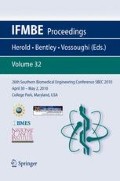Abstract
In this study, we present the results of fabricating novel methacrylate-containing hydrogel scaffolds to be used as corneal replacement and augmentation. The materials properties of the hydrogel scaffolds and the responses of human corneal epithelial cells towards the hydrogel scaffolds were examined. The hydrogel scaffold is based on polyallylamine (PAH), glycidyl methacrylate (GMA) and polyethylene glycol (PEG). The solution mixture of PAH, GMA and PEG was subjected to ultraviolet irradiation to form hydrogel. Hydrogels with different compositions of PEG were fabricated and examined for the materials properties as well as the responses following the deposition of human corneal epithelial cells. Materials properties of the hydrogels were examined including viscoelastic properties using rheometry, pore size by mercury intrusion porosimetry, physical stability at different pH, swelling ratio when immersed in phosphate-buffered saline, and surface wettability through contact angle goniometry. In addition, the morphologies of the hydrogels were examined using scanning electron microscopy. Proteins including collagen type I, fibronectin and bovine serum albumin were incorporated, both individually and in a mixture, into some of the hydorgels. Human corneal epithelial cells, in either serum-free medium or in serum-rich medium, were allowed to deposit onto the hydrogels, after which their responses were examined in terms of adhesion, spreading and morphology. Tissue culture polystyrene (TCPS) was used for comparison purpose. Only when proteins were present in either the hydrogels or serum-rich medium did adhesion of cells on hydrogel occur, although no noticeable spreading was observed. Cells only adhered and spread on TCPS in the presence of proteins. In comparison, cells neither adhered nor spread on hydrogel in the absence of proteins. The results suggest that both the presence of proteins and substrate stiffness are important factors that affect the responses of corneal epithelial cells.
Access this chapter
Tax calculation will be finalised at checkout
Purchases are for personal use only
Preview
Unable to display preview. Download preview PDF.
Author information
Authors and Affiliations
Editor information
Editors and Affiliations
Rights and permissions
Copyright information
© 2010 Springer-Verlag Berlin Heidelberg
About this paper
Cite this paper
Reis, L.G., Pattekari, P., Sit, P.S. (2010). Modification of Hydrogel Scaffolds for the Modulation of Corneal Epithelial Cell Responses. In: Herold, K.E., Vossoughi, J., Bentley, W.E. (eds) 26th Southern Biomedical Engineering Conference SBEC 2010, April 30 - May 2, 2010, College Park, Maryland, USA. IFMBE Proceedings, vol 32. Springer, Berlin, Heidelberg. https://doi.org/10.1007/978-3-642-14998-6_45
Download citation
DOI: https://doi.org/10.1007/978-3-642-14998-6_45
Publisher Name: Springer, Berlin, Heidelberg
Print ISBN: 978-3-642-14997-9
Online ISBN: 978-3-642-14998-6
eBook Packages: EngineeringEngineering (R0)

